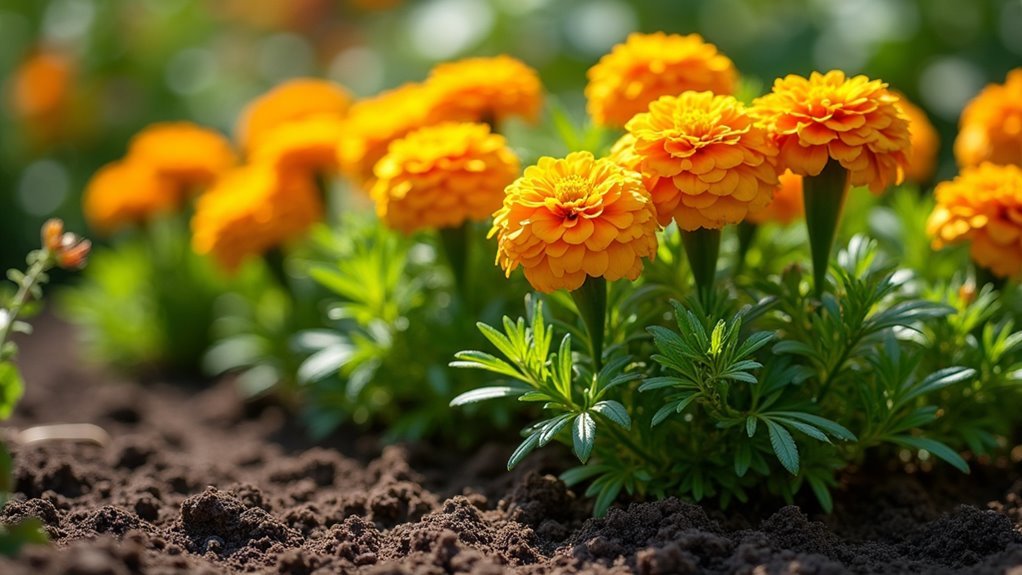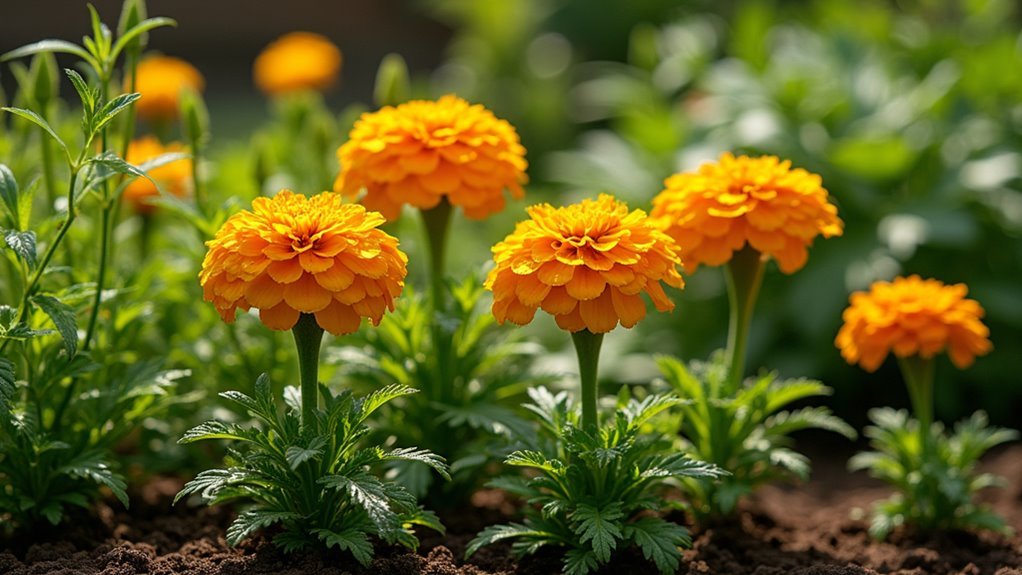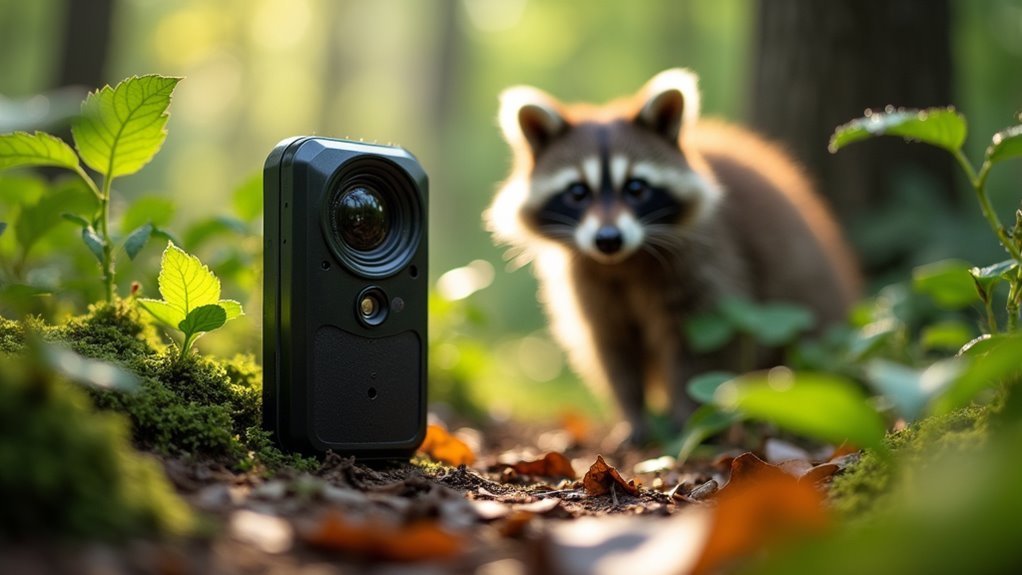You can eliminate destructive nematodes from your garden using three powerful companion plants. French marigolds produce thiophene compounds that act as natural nematicides—plant varieties like Tangerine or Bolero in solid patches spaced 7 inches apart. Painted daisy releases potent toxins directly from its root system to target root-knot nematodes while adding beautiful flowers to your garden. Castor bean creates rapid-growing biomass that’s particularly effective in warm climates, though you’ll need to handle it carefully due to its toxicity. These natural solutions will transform your pest management approach.
French Marigolds: Natural Nematicide Producers

Among nature’s most effective biological weapons against soil pests, French marigolds (Tagetes patula) stand out as powerful nematode fighters that’ll transform your garden’s underground ecosystem.
These remarkable plants produce thiophene and other toxic compounds that act as a natural nematicide, specifically targeting root-knot nematodes in your soil.
For maximum pest management effectiveness, plant varieties like Tangerine, Bolero, and Goldie as cover crops in solid patches spaced 7 inches apart.
While their nematode-fighting power lasts only one growing season, integrating French marigolds into your garden rotations provides continuous protection against nematode infestations.
This companion planting strategy greatly enhances soil health while reducing your dependence on chemical treatments, making it an essential element of sustainable gardening practices.
Painted Daisy: Toxic Root Protection Against Soil Pests
While French marigolds excel at producing thiophene compounds, Painted Daisy (Chrysanthemum coccineum) takes a different approach by releasing potent toxins directly from its root system to eliminate root-knot nematodes.
Painted Daisy’s roots release natural toxins that target and eliminate destructive root-knot nematodes without synthetic chemicals.
This companion plant offers you a dual-purpose solution that combines natural pest control with garden beauty. You’ll find it particularly effective when integrated into your pest management strategy through crop rotation or cover cropping.
Here’s how Painted Daisy enhances your garden:
- Green Manure Power – Tilling it into soil dramatically reduces nematode populations while improving soil health.
- Chemical-Free Control – Eliminates need for synthetic nematicides through natural toxin production.
- Aesthetic Appeal – Provides vibrant flowers that beautify your garden while protecting against soil pests.
For long-term nematode management, you can’t beat this plant’s effectiveness in creating healthier growing conditions for subsequent crops.
Castor Bean: Powerful Green Manure for Nematode Elimination

Castor bean (Ricinus communis) delivers one of nature’s most potent weapons against soil nematodes through its rapid-growing biomass and toxic compound production.
You’ll find this green manure particularly effective in warm climates where it achieves exceptional rapid growth rates. When you till castor bean into your soil before it sets seed, the plant’s toxic compounds specifically target nematode populations, markedly reducing these persistent pest problems.
As a cover crop, castor bean doesn’t just manage pests—it actively improves soil health for your future plantings. You can rely on its quick establishment to provide fast nematode control solutions.
However, exercise extreme caution since all plant parts are highly toxic to humans and animals if ingested, requiring careful handling throughout the growing season.
Frequently Asked Questions
What Plants Repel Nematodes?
You can plant French marigolds, painted daisies, and castor beans to repel nematodes. Velvet beans, partridge pea, rapeseed, and showy crotalaria also work effectively when you’re incorporating them into soil.
What Is the Companion Plant for Nematodes?
You’ll find French marigolds are your best companion plant for fighting nematodes. They produce natural chemicals that kill various nematode types. Plant them in solid patches or strips for maximum effectiveness against these pests.
What Kills Nematodes Instantly?
You can’t kill nematodes instantly with companion plants. French Marigold, Painted Daisy, and Castor Bean release toxins gradually when decomposed into soil, providing effective but slow nematode control over time.
What Eats Nematodes in Soil?
You’ll find predatory nematodes, beneficial fungi like Arthrobotrys, bacteria, protozoa, predatory mites, and certain beetles actively consume soil nematodes. These natural predators work together in diverse soil ecosystems to control nematode populations effectively.
In Summary
You’ve discovered three powerful allies in your fight against nematodes. Plant French marigolds throughout your garden beds to release natural nematicides into the soil. Add painted daisies for their toxic root compounds that’ll repel these microscopic pests. Don’t overlook castor beans as green manure – they’ll eliminate nematodes while enriching your soil. By incorporating these companion plants, you’re creating a natural defense system that’ll protect your crops without harsh chemicals.





Leave a Reply